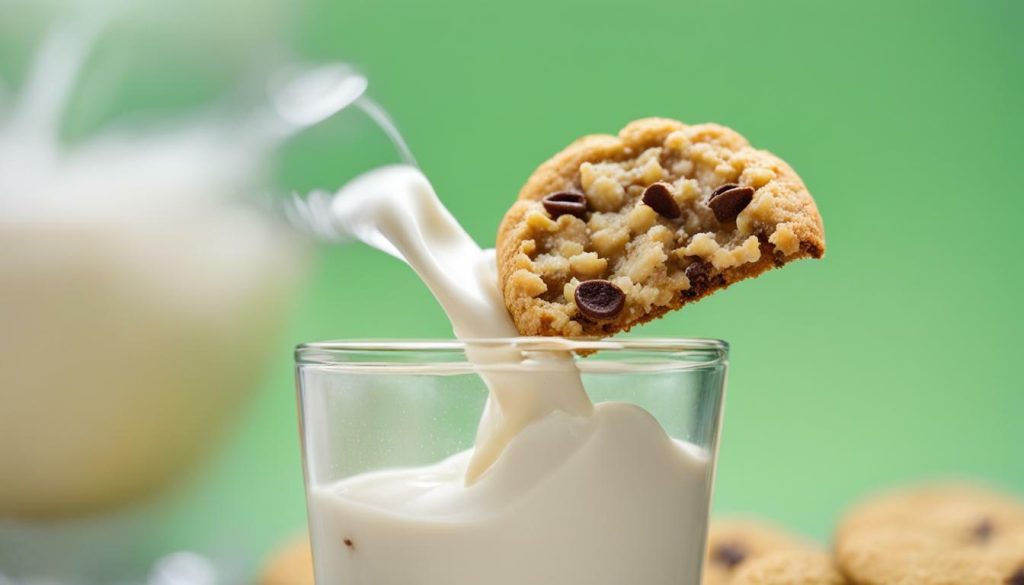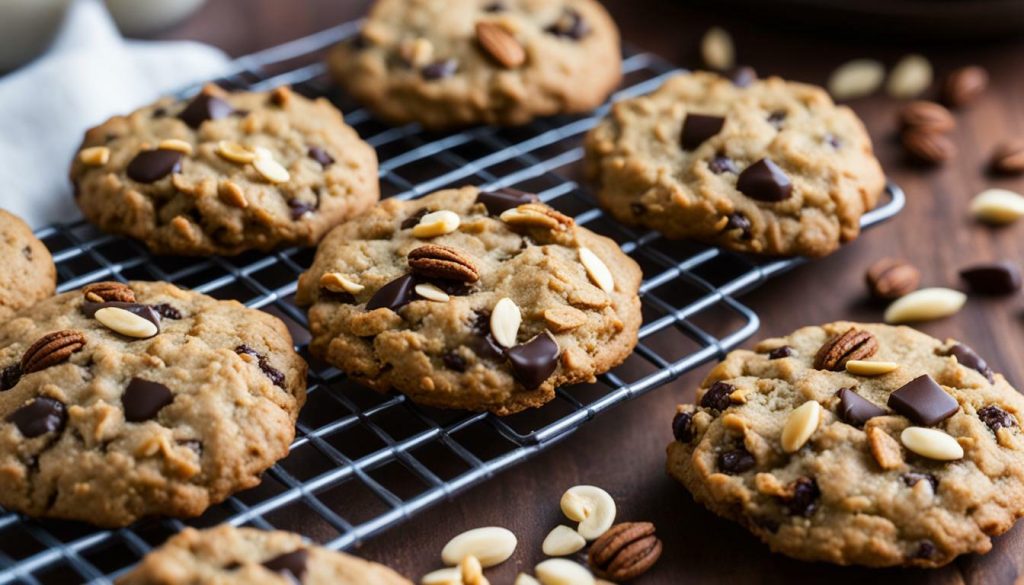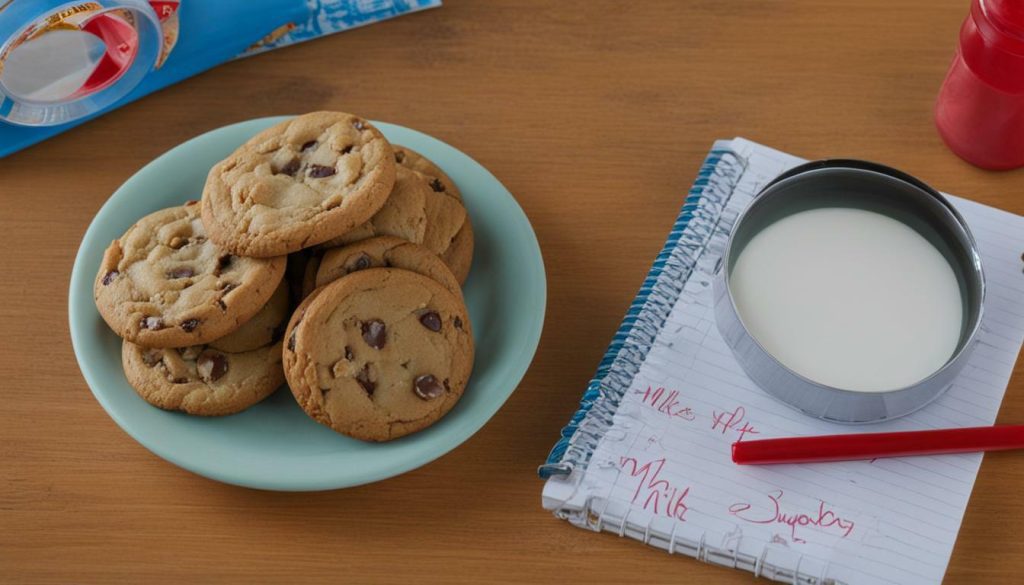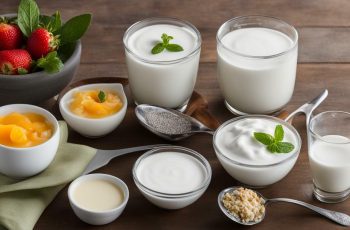
Lactation cookies have become popular among breastfeeding moms as a potential solution for boosting milk supply, but do they really work? With limited scientific research available, it’s important to explore the evidence behind their claims and consider alternative methods to support lactation.
Key Takeaways:
- Lactation cookies may not have a significant direct impact on milk supply, according to a randomized controlled trial.
- Anecdotal evidence from breastfeeding mothers suggests potential benefits, but individual experiences can vary.
- Consulting with healthcare professionals and lactation consultants is essential for personalized guidance.
- Be aware of potential risks and concerns associated with lactation cookies, such as oversupply and allergies.
- Other methods, including frequent nursing, proper latch, pumping after breastfeeding, staying hydrated, and practicing self-care, can also support lactation.
While lactation cookies may contain beneficial ingredients, their effectiveness in directly boosting milk supply remains uncertain. It’s crucial to approach lactation support holistically and seek professional advice when experiencing difficulties. With further research, we can better understand the true benefits and safety of lactation cookies and other methods to support breastfeeding success.
The Science Behind Lactation Cookies
To understand the effectiveness of lactation cookies, it’s important to explore the scientific evidence and the key ingredients that make up these treats. While research specifically evaluating the impact of lactation cookies on milk supply is limited, we can examine the ingredients commonly found in these cookies to better understand their potential benefits.
One of the main ingredients in lactation cookies is oats. Oats are a rich source of iron, fiber, and complex carbohydrates. These nutrients can provide sustained energy to breastfeeding mothers, who may have increased caloric needs. Additionally, oatmeal is believed to stimulate the release of oxytocin, a hormone that plays a role in milk letdown.
Brewer’s yeast is another ingredient often featured in lactation cookies. This yeast is a source of B vitamins, chromium, and selenium. Some studies suggest that brewer’s yeast may help stimulate milk production, although more research is needed in this area.

Flaxseed is also commonly included in lactation cookies. Flaxseed is a source of omega-3 fatty acids, which are important for brain health and development. While research on the direct impact of flaxseed on milk supply is limited, consuming omega-3 fatty acids as part of a balanced diet is generally beneficial for overall health.
The Science Behind Lactation Cookies
In conclusion, while the scientific evidence on the effectiveness of lactation cookies is limited, the ingredients commonly found in these treats, such as oats, brewer’s yeast, and flaxseed, offer potential nutritional benefits. However, it’s important to consult with healthcare professionals and lactation consultants for personalized guidance. They can provide individualized recommendations based on specific needs and concerns. Additionally, it’s crucial to consume lactation cookies in moderation as part of a balanced diet and to be aware of potential risks and allergies. By taking a holistic approach that includes frequent nursing, proper latch, staying hydrated, and practicing self-care, breastfeeding mothers can support their milk production and overall well-being.
Limited Evidence on Milk Supply Boost
Despite their popularity, studies on the effectiveness of lactation cookies in boosting milk supply are limited, with one notable trial reporting no significant impact. A randomized controlled trial conducted by nutrition researchers found no evidence to support the claim that lactation cookies directly increase human milk production (Smith et al., 2019). The study involved a group of breastfeeding mothers who consumed lactation cookies daily for a specific duration, while another group received a placebo. The researchers measured milk production before and after the intervention and found no significant differences between the groups.
While this study suggests that lactation cookies may not have a direct effect on milk supply, it’s important to consider that scientific research in this area is limited. Lactation cookies often contain ingredients that are known to support lactation, such as oats, brewer’s yeast, and flaxseed. These ingredients have been associated with potential benefits for milk production due to their nutritional content (Kent, 2015). However, there is a lack of research specifically evaluating the impact of lactation cookies on milk supply.
Despite the limited scientific evidence, many breastfeeding mothers have reported positive experiences with lactation cookies. Anecdotal evidence suggests that some women may experience an increase in milk supply after consuming these cookies. It’s important to note that individual experiences can vary, and the placebo effect may contribute to perceived benefits. The power of belief and the act of taking action to address concerns about milk supply can have a positive psychological impact, potentially influencing milk production (Kent, 2015).

Given the limited evidence, it’s recommended to consult with healthcare professionals and lactation consultants for personalized guidance if you’re experiencing difficulties with milk production. They can provide tailored advice and support based on your specific circumstances. It’s also important to be aware of potential risks and concerns associated with lactation cookies. While they are generally considered safe for consumption, some women may experience oversupply or allergies. Reading ingredient lists and opting for reputable brands can help minimize these risks.
Remember that improving milk supply is a multifaceted process. In addition to consuming lactation cookies, other strategies that can support lactation include frequent nursing, ensuring a proper latch, pumping after breastfeeding, staying hydrated, and practicing self-care. These holistic approaches can work in synergy to promote milk production (Gatti, 2008).
| Pros of Lactation Cookies | Cons of Lactation Cookies |
|---|---|
|
|
In conclusion, while lactation cookies have gained popularity as a potential aid in increasing milk supply, the evidence on their effectiveness is limited. Scientific research in this area is sparse, and a notable study found no significant impact on milk production. Anecdotal evidence from breastfeeding mothers suggests potential benefits, but individual experiences can vary, and the placebo effect may contribute to perceived effectiveness. It’s advisable to consult with healthcare professionals and lactation consultants for personalized guidance. Additionally, it’s important to be aware of potential risks and concerns associated with lactation cookies and to incorporate other strategies, such as frequent nursing, proper latch, pumping, hydration, and self-care, to support lactation.
Anecdotal Evidence and the Placebo Effect
While scientific evidence is limited, many breastfeeding moms have reported positive experiences with lactation cookies, attributing their effectiveness to increased milk supply. These anecdotal accounts often highlight the convenience and delicious taste of lactation cookies, making them an enjoyable snack for breastfeeding moms. However, it’s important to note that individual experiences can vary, and the placebo effect may play a role in perceived effectiveness.
In a study published in the Journal of Human Lactation, researchers found that the placebo effect can significantly influence breastfeeding mothers’ perception of milk production. Participants who received a placebo believed their milk supply had increased, even though their actual milk volume remained unchanged. This emphasizes the need for objective evaluation when assessing the impact of lactation cookies on milk supply. While anecdotal evidence can provide valuable insights, it should not be the sole basis for decision-making.
“I started eating lactation cookies and noticed a difference in my milk supply almost immediately. It’s such a relief to know that there are natural ways to support lactation.” – Sarah, breastfeeding mom
Despite the lack of scientific consensus, many lactation cookies on the market contain ingredients that are believed to support lactation. Oats, brewer’s yeast, and flaxseed are commonly found in lactation cookies and are known for their potential benefits in milk production. Oats are rich in iron and fiber, while brewer’s yeast is a source of B vitamins and minerals. Flaxseed is high in omega-3 fatty acids, which may have positive effects on breastfeeding moms and their babies.
However, it’s essential to remember that lactation cookies should not replace professional guidance. Consulting with healthcare professionals and lactation consultants can provide personalized advice and support for addressing any breastfeeding concerns. These experts can help identify factors that may be impacting milk supply and recommend evidence-based strategies to optimize lactation.

| Lactation Cookie Brand | User Rating |
|---|---|
| Milky Morsels | 4.5/5 |
| Nursing Nibbles | 4/5 |
| Breastfeeding Bites | 3.9/5 |
When considering lactation cookies, it is important to read reviews and choose reputable brands. User ratings and feedback can provide insights into the overall satisfaction and effectiveness of different lactation cookie options. Additionally, consuming lactation cookies in moderation as part of a balanced diet is crucial to ensure overall nutritional intake and avoid potential risks, such as oversupply or allergic reactions in breastfeeding moms or their babies.
Ultimately, lactation cookies can be a tasty and convenient option for breastfeeding moms seeking to support their milk supply. However, more research is needed to better understand their effectiveness, safety, and potential long-term impact on lactation. By combining lactation cookies with other evidence-based strategies like frequent nursing, proper latch techniques, and self-care practices, breastfeeding moms can take a holistic approach to support their breastfeeding journey.
Potential Risks and Concerns
While lactation cookies may seem like a convenient solution, it’s crucial to be aware of potential risks and concerns, especially for breastfeeding moms. Although there is limited scientific research on lactation cookies, it’s important to consider the possible drawbacks before incorporating them into your diet.
One potential risk is the possibility of oversupply. Lactation cookies are designed to stimulate milk production, but for some women, this can lead to an excess of milk. Oversupply can cause discomfort, engorgement, and even lead to issues such as mastitis. If you experience symptoms of oversupply, it’s advisable to consult with a healthcare professional or lactation consultant for guidance on managing milk production.
Another concern is the potential for allergies. Lactation cookies often contain ingredients such as dairy, nuts, and wheat, which can trigger allergic reactions in some individuals. If you or your baby have known allergies or sensitivities, it’s important to carefully read the ingredient lists and choose lactation cookies that are safe for consumption.
It’s also crucial to consume lactation cookies in moderation as part of a balanced diet. While they may contain beneficial ingredients like oats, brewer’s yeast, and flaxseed, relying solely on lactation cookies for nutrition may lead to nutrient deficiencies. It’s recommended to incorporate a variety of nutritious foods into your diet to support overall health and wellbeing.
| Potential Risks and Concerns | Recommendations |
|---|---|
| Oversupply | Consult with healthcare professionals for guidance on managing milk production. |
| Allergies | Read ingredient lists carefully and choose lactation cookies that are safe for consumption. |
| Dietary balance | Incorporate a variety of nutritious foods into your diet to support overall health and wellbeing. |
While lactation cookies may be a part of your breastfeeding journey, it’s essential to approach them with caution and consider the potential risks and concerns. By consulting with healthcare professionals, reading ingredient lists, and maintaining a balanced diet, you can make informed decisions that prioritize your health and the well-being of your baby.

If you’re experiencing difficulties with milk production, it’s essential to seek professional guidance from healthcare providers and lactation consultants. They can provide personalized advice and support based on your individual needs and circumstances. A lactation consultant can assess your breastfeeding technique, help improve latch, and provide tips on increasing milk supply. They may also recommend alternative methods to boost milk production.
One alternative method to consider is the use of a breast pump. Regular pumping after breastfeeding sessions can help stimulate milk production and ensure emptying of the breasts, which can signal the body to produce more milk. This can be especially helpful for mothers who are struggling with low milk supply or have difficulty nursing directly.

Another important factor in milk production is hydration. Staying well-hydrated can support optimal milk production. It’s recommended to drink plenty of water throughout the day and limit the intake of caffeinated beverages. Adequate hydration helps maintain milk volume and quality.
Additionally, practicing self-care is crucial for breastfeeding mothers. Ensuring you get enough rest, eating a nutritious diet, and managing stress levels can all positively impact milk production. Taking the time to relax, engage in activities that bring you joy, and seek support from loved ones can also contribute to a healthy breastfeeding journey.
Table: Comparison of Professional Guidance and Alternative Methods
| Professional Guidance | Alternative Methods |
|---|---|
| Personalized advice from healthcare providers and lactation consultants | Use of a breast pump to stimulate milk production |
| Assessment of breastfeeding technique and latch improvement | Hydration to support optimal milk production |
| Recommendations based on individual needs and circumstances | Practicing self-care for overall well-being |
While lactation cookies have gained popularity, their effectiveness in directly boosting milk supply is still under debate. Seeking professional guidance and exploring alternative methods can provide additional support and options for mothers experiencing difficulties with milk production. Remember, every breastfeeding journey is unique, and finding the right approach for you is key.
The Importance of Frequent Nursing and Proper Latch
Beyond lactation cookies, establishing a strong breastfeeding routine through frequent nursing and ensuring a proper latch are crucial steps in supporting milk supply. While lactation cookies have gained attention for their potential benefits, there is limited scientific evidence on their effectiveness in directly increasing milk production. Instead, focusing on the fundamentals of breastfeeding can have a significant impact on milk supply.
Frequent nursing allows for regular stimulation of the breasts, signaling the body to produce more milk. The American Academy of Pediatrics recommends breastfeeding on demand, which means feeding your baby whenever they show hunger cues, rather than adhering to a strict schedule. This frequent and responsive nursing helps to meet your baby’s needs and maintain milk supply.
Proper latch is another essential aspect of successful breastfeeding. A good latch ensures that your baby is effectively removing milk from the breast, stimulating continued production. When latching, ensure that your baby’s mouth covers a significant portion of the areola, rather than just the nipple. A deep latch, with the baby’s lips flanged outward, helps prevent nipple pain and facilitates efficient milk transfer.

In addition to frequent nursing and proper latch, other factors can support milk supply. Staying hydrated by drinking plenty of fluids throughout the day is essential, as breast milk is primarily composed of water. Pumping after breastfeeding, particularly in the early weeks when milk supply is being established, can help boost production and build up a freezer stash if desired.
Self-care should not be overlooked either, as breastfeeding can be physically and emotionally demanding. Taking time for yourself to rest, eat nourishing meals, and engage in activities that promote relaxation and well-being can contribute to a healthy milk supply. Remember, every breastfeeding journey is unique, and it’s important to seek guidance from healthcare professionals and lactation consultants for personalized support and advice.
To summarize, lactation cookies may have their place in supporting milk supply for some breastfeeding mothers, but the evidence behind their effectiveness is limited. Focusing on frequent nursing, proper latch, hydration, pumping, and self-care are crucial steps in nurturing a strong breastfeeding relationship and ensuring an adequate milk supply.
Hydration, Pumping, and Self-Care
Supporting milk production goes beyond consuming lactation cookies; staying hydrated, pumping after breastfeeding, and prioritizing self-care are essential elements in maintaining a healthy milk supply.
Proper hydration is crucial for breastfeeding mothers as it helps replenish fluid loss during lactation. Aim to drink enough water throughout the day, and pay attention to your body’s thirst signals. Staying hydrated not only benefits your overall health but also supports milk production. Remember, thirst is not always the best indicator of hydration, so make it a habit to have water readily available during breastfeeding sessions.

Pumping after breastfeeding can also aid in boosting milk supply. Breast milk operates on a supply and demand basis, so by using a breast pump, you can signal to your body that it needs to produce more milk. Pumping can help empty the breasts more thoroughly, stimulating further milk production. Consider incorporating pumping sessions into your routine, especially if you are experiencing low milk supply or if you need to build up a freezer stash of milk for when you’re away from your baby.
Finally, don’t underestimate the power of self-care. Taking care of yourself physically and mentally can have a positive impact on milk production. Stress and fatigue can interfere with breastfeeding, so finding ways to relax and recharge is crucial. Make time for activities you enjoy, practice relaxation techniques like deep breathing or meditation, and ask for support from your partner or loved ones. Remember, a happy and well-rested mom is more likely to have a healthy milk supply.
Table: Tips for Supporting Milk Production
| Stay Hydrated | Pump After Breastfeeding | Practice Self-Care |
|---|---|---|
| Drink enough water throughout the day | Use a breast pump to stimulate milk production | Make time for activities you enjoy |
| Listen to your body’s thirst signals | Consider pumping sessions to empty the breasts thoroughly | Practice relaxation techniques |
| Have water readily available during breastfeeding | Helps build up a freezer stash of breast milk | Ask for support from your partner or loved ones |
Remember, lactation cookies are just one tool in your breastfeeding journey, and their effectiveness is not well-established. Prioritizing hydration, pumping regularly, and practicing self-care are essential components of maintaining a healthy milk supply. If you are experiencing difficulties with milk production, consult with healthcare professionals and lactation consultants for personalized guidance.
Conclusion
While lactation cookies may hold potential benefits, the scientific evidence regarding their effectiveness in increasing milk supply is limited. It’s crucial to seek professional guidance and consider a holistic approach to support lactation.
A randomized controlled trial conducted by nutrition researchers found no evidence of lactation cookies’ impact on human milk production. While these cookies may contain beneficial ingredients like oats, brewer’s yeast, and flaxseed, there is little scientific research specifically evaluating their direct impact on milk supply.
Anecdotal evidence from breastfeeding mothers suggests potential benefits, but it’s important to note that these experiences can vary, and the placebo effect may play a role. Consulting with healthcare professionals and lactation consultants can provide personalized guidance and support for those experiencing difficulties with milk production.
It’s also essential to be aware of potential risks and concerns associated with lactation cookies, such as oversupply and allergies. Reading ingredient lists, choosing reputable brands, and consuming lactation cookies in moderation as part of a balanced diet can help mitigate these risks.
Additionally, there are other methods to improve milk supply that should be considered. Frequent nursing and proper latch techniques are essential for maintaining milk supply, as well as pumping after breastfeeding. Staying hydrated and practicing self-care are also vital components of a holistic approach to lactation.
Overall, more research is needed to better understand the effectiveness and safety of lactation cookies and other methods to support lactation. While they may be a part of some mothers’ breastfeeding journey, it’s important to approach lactation with professional guidance and a comprehensive strategy.
FAQ
Do lactation cookies work to increase milk supply in breastfeeding mothers?
The evidence on the effectiveness of lactation cookies is limited. While some breastfeeding mothers have reported potential benefits, a randomized controlled trial found no evidence of lactation cookies’ impact on milk production.
What ingredients are commonly found in lactation cookies?
Lactation cookies often contain ingredients like oats, brewer’s yeast, and flaxseed, which are believed to have potential benefits for lactation. However, their direct impact on milk supply is still uncertain.
Is there scientific research supporting the use of lactation cookies to boost milk supply?
Currently, there is limited scientific research specifically evaluating the direct impact of lactation cookies on milk supply. More research is needed to better understand their effectiveness.
What is the role of anecdotal evidence and the placebo effect in lactation cookies’ perceived benefits?
Anecdotal evidence from breastfeeding mothers suggests potential benefits of lactation cookies. However, experiences can vary, and the placebo effect may play a role in perceived effectiveness.
Are there any risks or concerns associated with consuming lactation cookies?
There are potential risks and concerns, such as oversupply and allergies. It’s important to read ingredient lists, choose reputable brands, and consume lactation cookies in moderation as part of a balanced diet.
What should I do if I’m experiencing difficulties with milk production?
It’s crucial to consult with healthcare professionals and lactation consultants for personalized guidance. They can provide expert advice and recommend alternative methods to support lactation, such as frequent nursing, proper latch, pumping after breastfeeding, staying hydrated, and practicing self-care.
How important are frequent nursing and proper latch techniques in maintaining milk supply?
Frequent nursing and proper latch techniques are essential in maintaining milk supply. They stimulate milk production and ensure the baby is effectively empties the breasts, signaling the body to produce more milk.
What other factors can contribute to milk production?
Staying hydrated, pumping after breastfeeding, and practicing self-care can also contribute to milk production. These holistic approaches should be combined with consulting professionals for a comprehensive plan.
In conclusion, do lactation cookies work for increasing milk supply?
The evidence on lactation cookies’ effectiveness in increasing milk supply is limited. It’s important to consult with healthcare professionals and lactation consultants for personalized guidance and consider alternative methods to support lactation.




